As society slowly and painfully becomes more “woke,” we’re more careful than ever to identify and condemn cultural appropriation — the ugly exploitation of a culture for selfish gains. But not every cultural exchange is exploitative, and whether it’s through an exploration of personal identity, mutual respect, or just genuine curiosity, artists are constantly borrowing and sharing art and influence from other cultures. Through Intersect, a column by Matthew Ismael Ruiz, we’ll take a look at a pair of bands or musicians whose music represents a coalescence of disparate cultures to make something new.
Rafael Reyes got jumped into the Sherman Grant Hill Park 27 gang when he was 13 years old. He wears tattoos claiming his set across his back and stomach, and carries a rap sheet that reveals a life of putting in work on its behalf. You’ll never catch him without a blade on his person — short, black, and concealed.
But there’s another side to Reyes – the side that gravitates towards the night and worships Peter Murphy, that likes to wear nail polish, makeup, lace, and black leather. He might not be the first cholo goth, but along with his friend Dave Parley and their band Prayers, they’ve become its ambassadors. Reyes sings and writes, and Parley makes the beats. For them, it’s not just a band, it’s a movement.
Cholo goth is powerful because of its presumed contradictions — the violent machismo of Chicano gang culture and the sensitive self-expression of goth music. To be goth is to be outcast, but to be cholo goth is to be an outcast amongst outcasts. “I had to fight to dress this way, man,” Reyes tells us, his rings clicking on the conference room table we’re seated around. On the day Prayers visits the Remezcla office in Brooklyn, it’s 95 degrees and humid outside, but both Reyes and Parley are dressed completely in black, from boot to fingertip. Parley is wearing his signature beanie; Reyes’ shaved head is covered in tattoos.
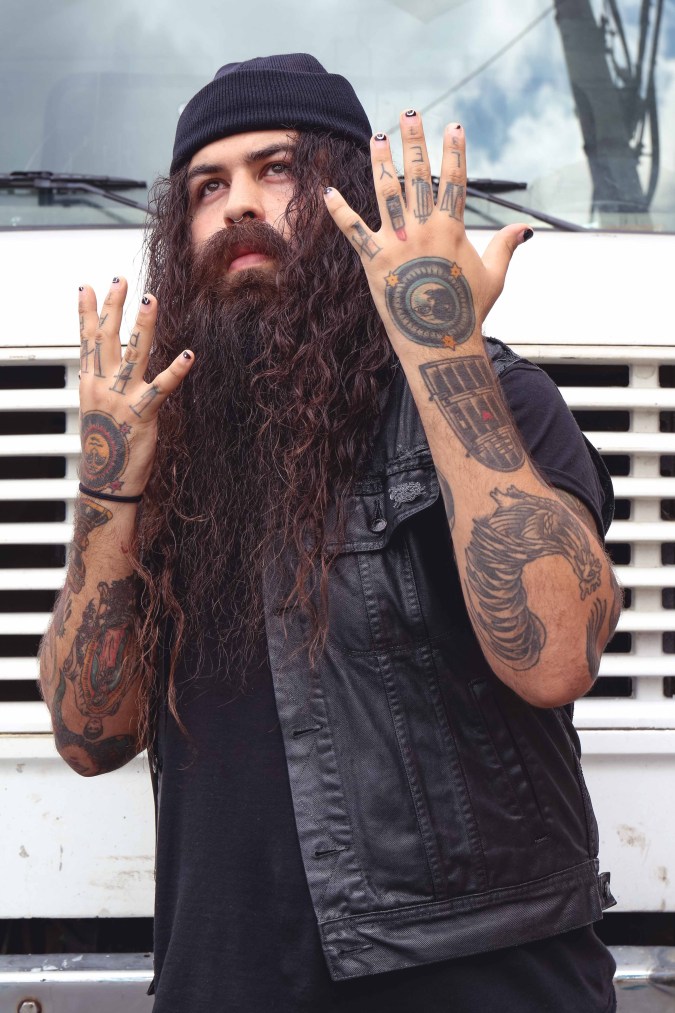
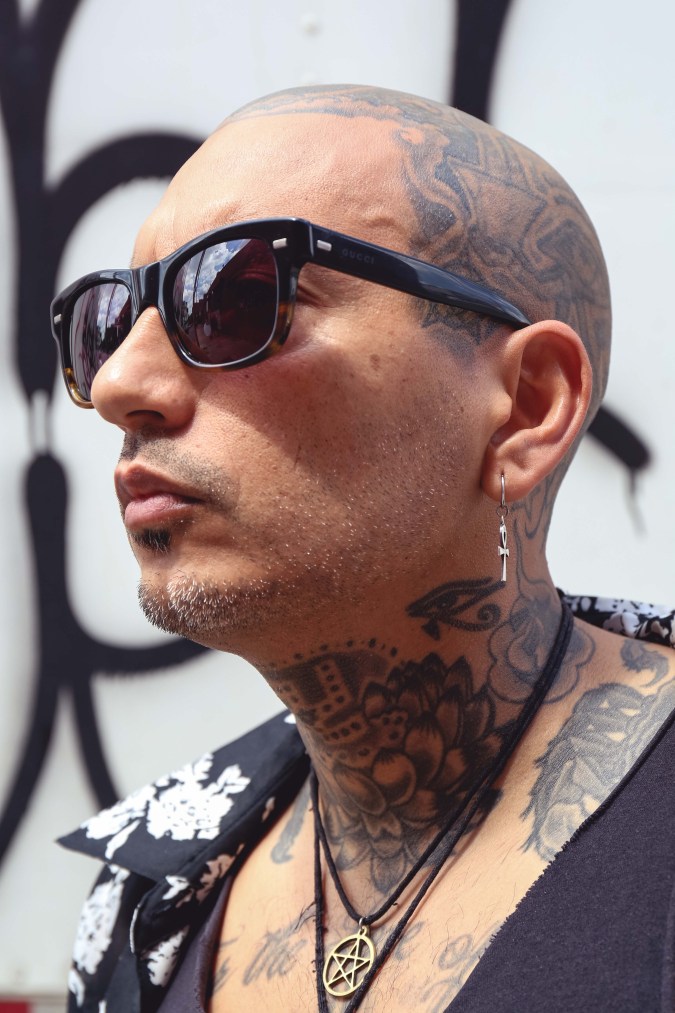
Dave Parley and Rafael Reyes, Photo by Itzel Alejandra Martinez
Even in a city full of weirdos, Prayers stands out. For many artists, that’s kind of the point, but because of Reyes’ history with the gang, the visibility makes them vulnerable. Prayers has never been more successful, minting new fans and making famous friends on the daily. They’ve collaborated with Kat Von D (“Black Leather”) and Blink 182’s Travis Barker (Young Gods), and Makonnen recently professed his fandom on stage during Prayers’ set at this year’s Afropunk Festival. But it could all be over in an instant — with two “strikes” on his record, any new “serious or violent” felony conviction will send Reyes to prison for life under California’s Three Strikes Sentencing Law. His lifelong fight to be himself is admirable, and the fact that he’s still making music is a testament to his resilience.
Sherman Heights Grant Park 27 is one of the oldest gangs in San Diego. As a staunch military town, San Diego boasts four bases and a recruiting depot. Reyes tells us the first gangs formed out of a need to protect the Chicano community — and the women, in particular — from harassment by sailors on shore leave. Over the years, as the public infrastructure failed these Chicano immigrant communities, the gangs evolved, stepping in to provide order through violence. Parley is from nearby Tijuana, but Reyes was born in Cotija, and his family snuck in when he was a baby with the help of his uncle, a coyote. When Reyes joined Sherman 27 in the 90s, it was a survival tactic, providing protection for his family. In order to make the streets safe for them to walk, he had to volunteer to get his ass kicked by a gang of cholos. “I joined a gang for them,” Reyes says. “That’s how much I love them.”
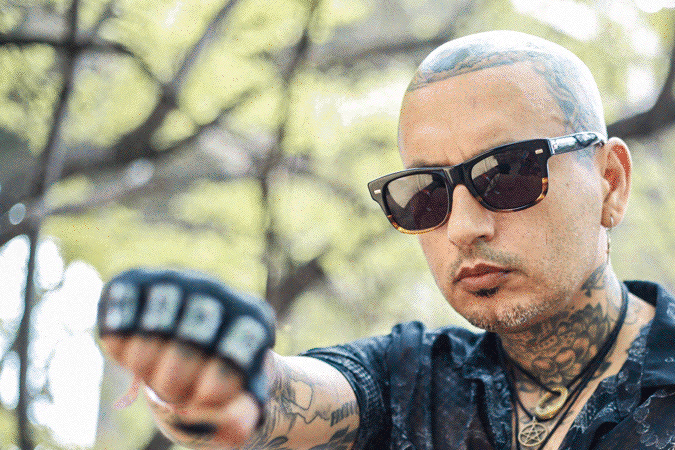
Prayers’ sound is relatively straightforward; Reyes’ lyrics are shouted through a vintage mic and filter, vacillating between threats of violence and doomsday wallowing over Parley hammering out beats on an analog drum machine, cutting through atmospheric whole notes with lightning-fast fingers and hyperspeed drums. On stage, he takes a half-squat with the Akai MPC5000 on a short stand just below his crotch. Reyes will often wear lipstick and clothing from the women’s section. When they played Afropunk, he rocked a sheer mesh shirt with an embroidered pattern, and did his best to keep from melting in the midday sun. He brandished a short knife as he sang about putting it to your face, and screamed a murderous “1-8-7 on a P-I-G” hook within earshot of the police working traffic outside the grounds.
The pair fit together like oil and water, like cholo and goth; Parley and Reyes fill each other’s negative space. Parley is physically hulking and verbally reserved, Reyes is small of stature and vocally forceful. “My weaknesses are his strengths, and his strengths are my weaknesses,” Reyes explains. “We complement each other. He is the day, I am the night. He is the sun, I am the moon. He is good and I am evil, and we balance each other. And that has allowed us to thrive.”
When they met, Reyes was in a band with Parley’s roommate called Vampire. Parley came to see the last show, and was blown away — not by the band, but by Reyes. He approached him, told him they should make music, and the next day, rolled up to Reyes’ house with his Akai, ready to make beats. The first day they cut four songs – the next, four more. Those eight tracks would become their first record, 2013’s SD Killwave. On the third day, Reyes had a show booked for his side project Nite Ritual, but he was feeling the music they had made so much that he asked Parley to join him. They played the record they had just made, and Prayers was born.
The name is an invention of Parley’s, part portmanteau (Parley + Reyes = Prayers), part humble reminder. When I ask him what it means, Parley tells me: “Hope…It’s the yin and yang, it’s the future of everything. What do you need? Yeah, you need wheels to drive, but without God, you’re going nowhere. That’s Prayers. We’re the gas for your car.”
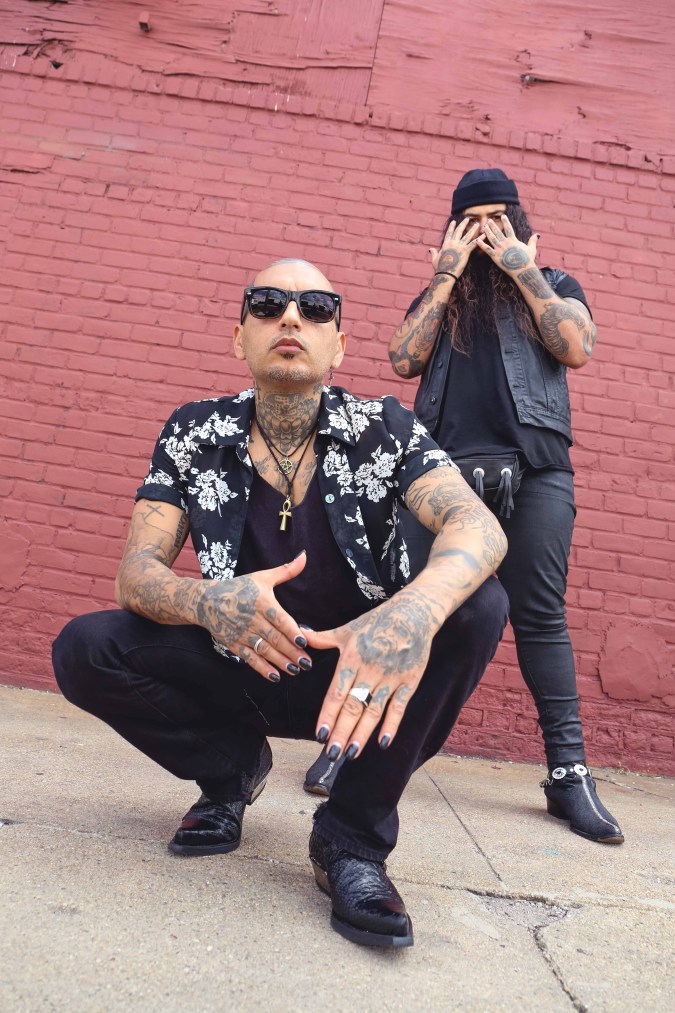
That Prayers has pioneered cholo goth is a source of immense pride for both the band and Sherman 27. Mugging for the camera in a Noisey mini-doc, his homies exalt his art and authenticity as they throw up signs and point at their tats. Success has made things easier, but Reyes in particular caught a lot of heat from his own community early in his career. Smaller dudes are always going to get tested more than big guys, but add the nails and the clothes into the mix, and he becomes a walking target for machismo-fueled rage.
“I joined a gang for them,” Reyes says. “That’s how much I love them.”
“I took so many hits when we first came out,” Reyes admits. “When I came out with “From Dog to God,” I was getting death threats: ‘You are a disgrace to our people,’ ‘Your music is garbage,’ all this stuff. I was under fire man, it was really heavy. And now everyone praises me.”
But he’s proud to be at the vanguard, to take those licks. On that very song, when he sings, “I never ran when they tested me,” it sounds like the words of someone who’s been tested his whole life. Reyes and Parley are invested in cholo goth as a movement, fighting the fight to fly their freak flags. It’s a beautiful ethos, but one borne of poverty, oppression, and the battle between youth culture and conservative social norms, both in the United States and Mexico.
Back in the mid-aughts, pop punk and emo were reaching the apex of their mainstream popularity. By 2008, the tight pants, asymmetrical haircuts, and *feels* had trickled south of the border, where the clothes, haircuts, and men expressing feelings didn’t jibe with the heteronormative reality that dominates either side of the border. It came to a head with an actual riot, a mob led by gang members rolling through the city of Queretaro looking for “emos” to beat up. Threatened by the surging popularity of this threat to hypermasculinity, they responded the only way they knew how — violently.
In a 2008 WIRED article about the riots, Mexican editor and author Gustavo Arellano summed it up like this: ”What do you do when you are confronted with a question mark about sexuality in Mexico? You beat it up.” But the emo riots happened precisely because that question mark has become so prevalent in Mexican society, because the number of emos was too large to ignore, threatening the status quo.
Reyes and Parley might not be queer, but their music and videos toy with sexual norms and taboo, and Reyes clearly gets off on making people squirm. Homophobia is not unique to San Diego gangs or Chicano communities — you can find it in Congress just as easily as you can on the corner. In this way, their subversion doesn’t just challenge machismo in Latinx communities; it’s cross-cultural, too. Patriarchal oppression is maintained through fear, and as many strides as we’ve made in the representation of queer and gender non-conforming folks, people are still scared by a man wearing lipstick. “People are so afraid of [homosexuality] still,” Reyes says. “I’m a straight man, so is David, but we have gay friends, the gay community loves us and we love them. They’ve been so supportive. We have open minds and our hearts wide open.”
“When my life was shit, I wanted to kill myself.”
In communities like the one that birthed Sherman 27, violence is the most powerful social currency, the language everyone understands. That this homophobia is expressed violently is unsurprising; even Reyes admits that it was how he used to solve all his problems. Luckily for him, the music gives him an out — a way to release his rage without physically harming anyone. On one of their darkest songs, “Friends Are Poison,” Reyes sings of the kind of pain that can only come from being betrayed by those you love: “Born alone, die alone/No faith, no hope, I walk alone/People make me feel, make me feel the most alone/I only feel the love, kill the love when I’m alone.”
“If it wasn’t for that song, I probably would’ve already done something that I would’ve regretted,” he says. “Prayers would probably be no more. But this music has allowed me to push back without having to get physical. Because I am a two-striker, so anything that I do will land me in prison for the rest of my life. I am a real gang member…I’ve been in physical fist fights with the police. Now I’m just trying not to go to jail.”
But his past does not exist in a vacuum, and it often follows him. Prayers has been going for three years, but for 25 years before that, he was in the streets, banging. And while the cholo lifestyle and goth subculture may seem incongruous on the surface, the dark realities of gang life line up pretty well with dark goth fantasy.
“When my life was shit, I wanted to kill myself,” Reyes admits. “There were so many dark times, and I was over life…It wasn’t until life got good that now you’re like, ‘Oh man, I want to live.’”
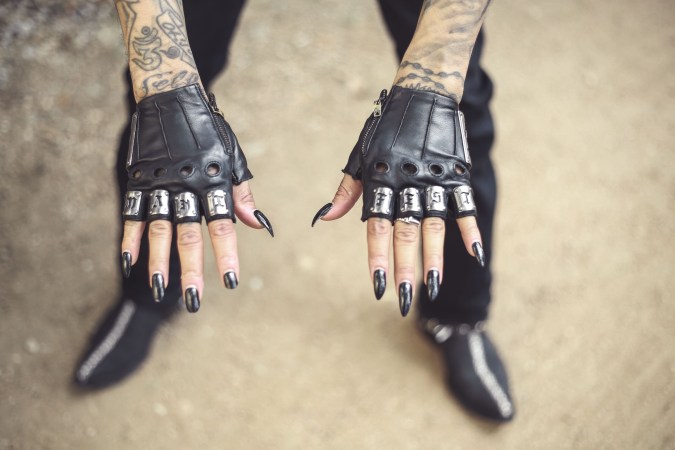
Goth is as much an aesthetic as it is a genre, but for people who prescribe to the lifestyle, the darkness that defines it is more positive than negative. Letting that darkness out is cathartic — for some, like Reyes, it’s the healthiest way to cope with the dreariness of existence. “Even though the content is dark, I need it, I need to express myself,” he says. “I can’t hold these things in, man. If I hold these things in, I have to do something, or else it’s going to destroy me.”
Prayers remain unsigned. They say they’ve talked with labels, but have yet to field an offer they’re interested in. (“I’m 41 man,” Reyes says. “I’ve been around the block…I know my worth, and I know our worth.”) They’ve got a new EP in the can, but they’re still deciding the best way to release it. Of the new material, Reyes will only say, “Our new stuff is very, very New Order.” As the two continue to grow together, they’re garnering new fans and turning more people onto cholo goth. But with that potential third strike hanging over his head, Reyes’ biggest challenge might just be staying out of trouble. To do so, he’ll have to stay one step ahead of his gangbanging past, with the understanding that it will always be right there behind him.
“I learned so much from it,” he says. “It made me the man who I am today.”




